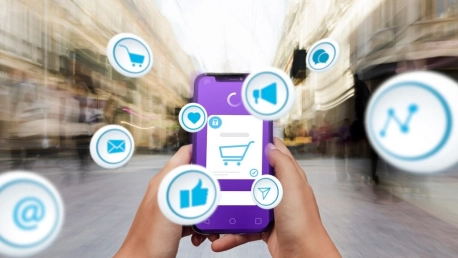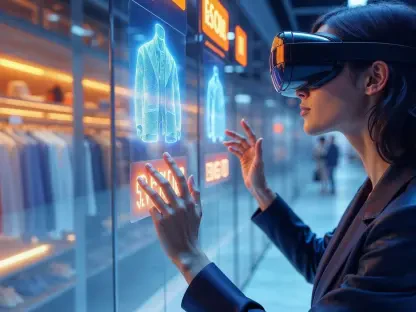The world of retail is being revolutionized by the burgeoning use of augmented reality (AR). Projected to surge from $2 billion in 2021 to an astounding $61 billion by 2031, AR technology is far from a passing fad. It’s a robust growth trend that promises to overhaul how we shop.Melding the digital with the physical, AR in the retail sector offers shoppers engaging and immersive experiences that are tailored to their personal preferences. This cutting-edge technology allows for a level of interaction and personalization that goes beyond traditional retail methods, capturing the interest of consumers and leading to increased satisfaction.As a result, retailers are increasingly leveraging AR to connect with their customers in novel ways. This not only enhances the shopping experience but also fosters a deeper sense of loyalty to brands that deliver these innovative solutions. Through AR, retailers take customer engagement to a new dimension, one where virtual assistance and convenience are paramount.While it’s still early days, the potential of AR in retail is evident. As it continues to evolve, we can expect it not just to become a common feature in shopping but to essentially redefine the retail space as we know it. The blend of interactivity with ease of access to information that AR provides is setting the stage for a future where the line between digital shopping and brick-and-mortar stores becomes increasingly blurred.
Defining Augmented Reality in the Retail Space
Augmented reality in the retail industry can be likened to a fusion of the real world with digital enhancements, creating a novel and mesmerizing shopping environment. Through this technology, digital visuals are superimposed onto our physical world, visible through devices like smartphones or AR glasses, adding a layer of interactivity and information to the customer experience. For shoppers, this means the ability to try on clothes virtually in a store without changing outfits or visualizing how a couch would fit in their living room without buying and bringing it home. The benefits extend to more informed decisions and heightened satisfaction, influencing both the consumer journey and the bottom line for retailers.With AR, static images and physical store layouts evolve into comprehensive, interactive environments. Customers are no longer passive participants but active decision-makers, influenced by immersive product demonstrations and tailored options. This expanded layer of engagement and interaction places a spotlight on how retailers can utilize AR to not just entice customers, but also to educate and guide their purchasing choices, creating a fully-rounded, memorable shopping experience.
Application Scenarios for Augmented Reality in Retail
When we consider the various ways AR can be applied in retail, the potential is as vast as the imagination. Packaging is transformed from a simple container to a dynamic platform for storytelling and customer engagement. Consumers can interact with their purchased products in meaningful ways, delving into brand stories or accessing additional content with a scan of a smartphone.Similarly, AR brings the concept of customization into the hands of the consumer, offering them the power to create and visualize products tailored to their preferences. Transparency in product ingredients is another area where AR shines, furnishing consumers with detailed knowledge about what they’re putting into or onto their bodies. Navigating sprawling retail stores is made simpler and more engaging with AR-guided pathways, and learning about products through AR tutorials can influence purchasing decisions, particularly for complex or DIY items.
Who Gains from Augmented Reality in Retail?
Both consumers and businesses stand to benefit enormously from the implementation of AR in retail. Consumers enjoy a more dynamic shopping experience that allows for virtual try-ons and deeper product exploration. This not only makes shopping more enjoyable but also eliminates much of the guesswork that often comes with online or large store purchases.On the flip side, businesses gain an edge in a competitive market by providing unique and immersive experiences that foster a stronger connection with their consumers. Insight into customer interactions with AR also opens up new avenues for personalized marketing and product development, helping businesses keep pace with changes in consumer behavior and stay ahead of the competition.
Strategies for Integrating AR in Retail Operations
Incorporating augmented reality (AR) into a business’s offerings requires a well-planned strategy. Initially, companies must pinpoint their goals and identify compelling applications for AR. This helps in choosing the right technology that meets both business objectives and consumer expectations.Creating engaging AR content is crucial, and businesses have to decide whether to build capabilities internally or collaborate with specialized agencies. Integration with current e-commerce infrastructure is vital, ensuring a coherent customer journey. The right hardware, accessible to consumers, is also a necessity for effective AR experiences.Customer trials are a fundamental aspect of rolling out AR, with shopper insights serving to refine the technology. Staff training is equally important, as knowledgeable employees can help customers navigate new AR features. Monitoring performance through analytics will guide ongoing improvements.As the retail sector evolves, major players are already experimenting with AR. It’s becoming a transformative tool in the retail landscape, reshaping customer-business interactions. For stores aiming to stay ahead, embracing AR will soon not be just an option, but an imperative part of the retail evolution.









